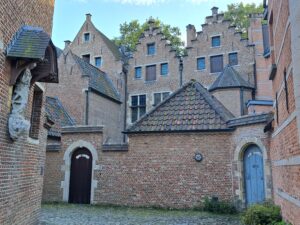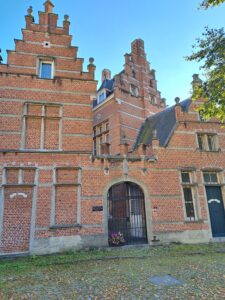







Of all beguinages I visited the beguinage of Antwerp felt most like an oasis: In the middle of this beguinage there is a little park with a big meadow, many old trees and many statues of saints. The park is surrounded by a hedge and has a gate as an entrance. I really enjoyed walking through the park because of the old, green trees, the warm sun shining on my face and the twittering of the birds.
A sign at the entrance to the park explains that it is “a retreat for silence, meditation and prayer”. So each visitor should “respect this atmosphere of calm”. Another sign draws attention to the rule that visitors are requested not to be loud. In fact, there were many people sitting on benches or lying on the grass just to relax and enjoy the sun.
The park is surrounded by the old houses of the beguines. All houses have a wall with a door in front – so that the beguines could probably feel safer. That means: To get inside there are both the door of the wall and the door of the house to enter.
The whole beguinage as itself is also surrounded by an additional wall with a gate. So the importance of the security aspect was very perceptible.
In the church of the beguinage there are 14 pictures showing the 14 stations of Jesus’ Way of the Cross. Besides, there are many holy figures. The strong religiosity of the beguines I could see at the doors in the of their houses also: On nearly each door there is the name of a saint (female and male saints). For example I saw the names St. Ignatius, St. Rosalia, St. Franciscus, St. Martha, St. Josef, St. Ludovicus, St. Mattheus, St. Gudula, St. Johanna, St. Lucas, St. Magdalena, St. Anna and many, many more.
The beguinage has still inhabitants: A sign at the entrance makes clear that male persons are requested not to visit the inhabitants after 6 pm. For me, this rule was a bit surprising because I couldn’t imagine that male persons are still “not that welcome” in this (historic) place. But this rule is an example that original understandings are still practiced and still alive.
So very characteristic for the beguinage were the big surrounding wall, the walls in front of the houses, the names of saints on the doors, the green park in the middle and the church.
To sum up I’d like to say that this beguinage with its little park, its old trees and its twittering of birds was so idyllic that I instantly knew that it will be one of my favourite ones although it was the first beguinage I had ever seen at that time.












